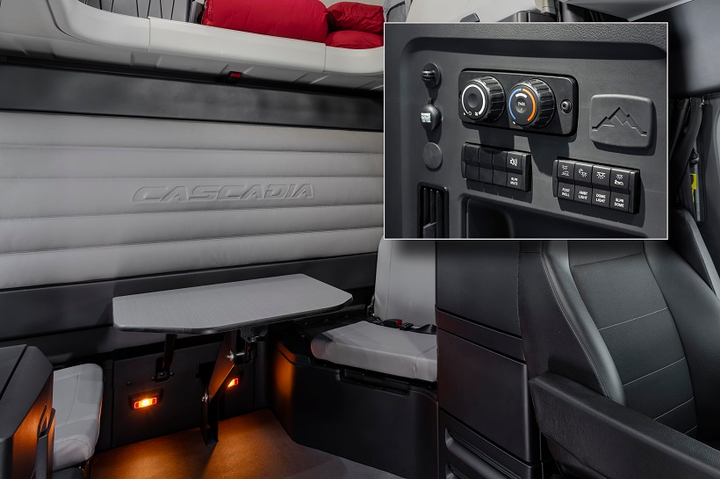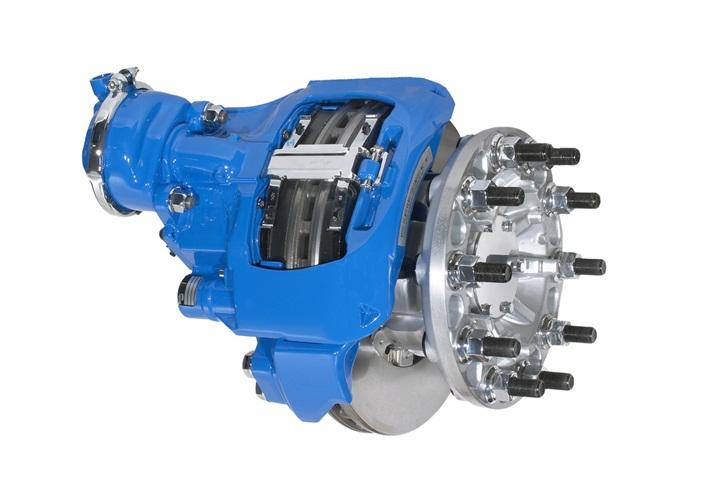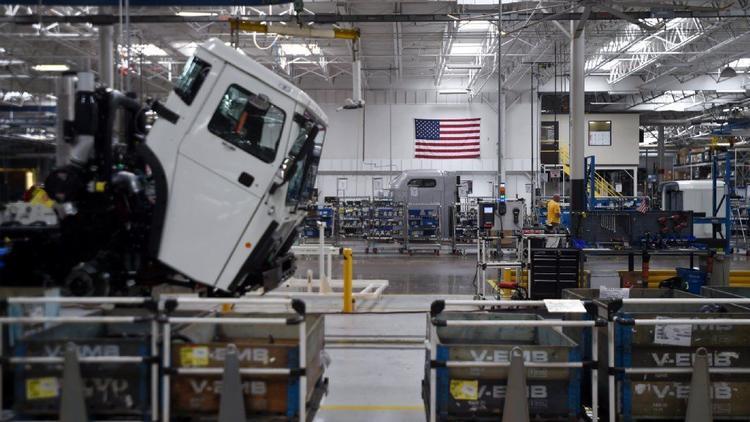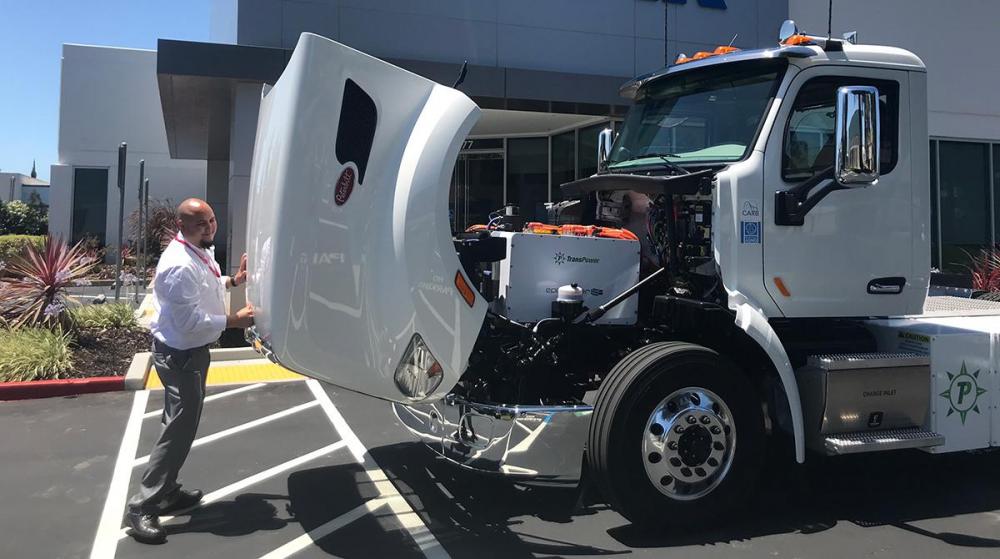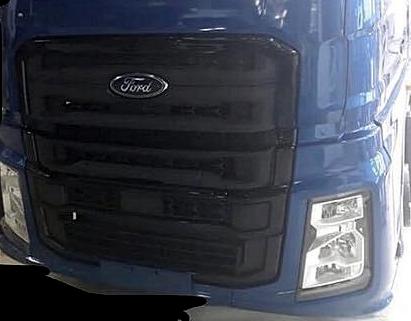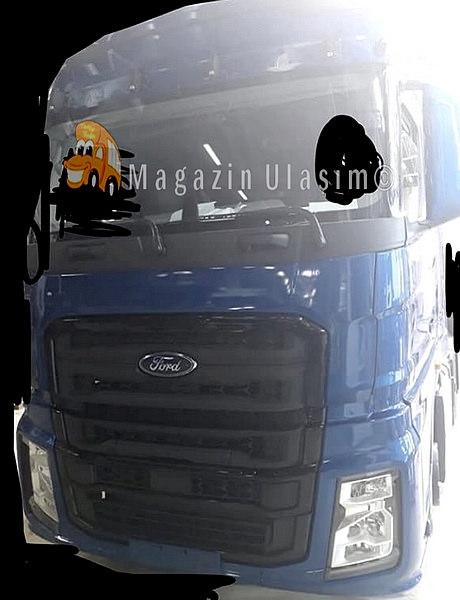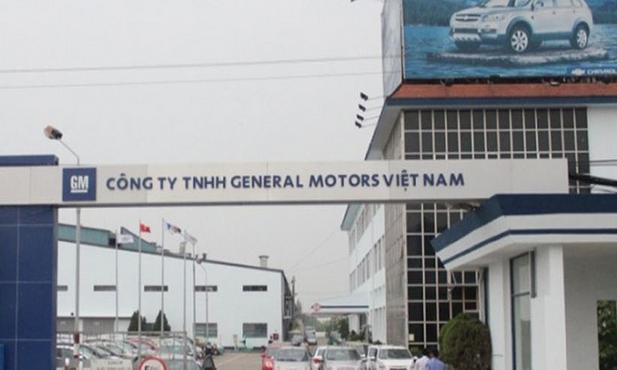
kscarbel2
Moderator-
Posts
18,854 -
Joined
-
Days Won
114
Content Type
Profiles
Forums
Gallery
Events
Blogs
BMT Wiki
Collections
Store
Everything posted by kscarbel2
-
Battery Powered HVAC Available for New Cascadia Models
kscarbel2 replied to kscarbel2's topic in Trucking News
It's noteworthy, and troubling, that world class battery powered HVAC systems have already been available on major brand Chinese heavy trucks for three years. -
Heavy Duty Trucking (HDT) / July 3, 2018 A battery powered HVAC system is now available as a factory-installed option for new Freightliner Cascadia truck models. Available on all new Cascadia sleeper sizes and bunk styles, the battery powered HVAC system reduces emissions by allowing drivers to maintain a comfortable temperature overnight in their cab without idling the engine. Increased airflow from a floor outlet further improves driver comfort, and the system is integrated with the truck’s Optimized Idle feature for comfort. The battery powered HVAC system is able to provide 10 hours of cooling or 34 hours of heating to the cab when parked. The battery powered HVAC system has a dual evaporator design and the compressor only runs in parked mode to improve reliability. The system is fully integrated with vehicle power management to preserve engine starting. All system components are serviceable, and most can be reached without removing the cabinet where it is housed. For 60- and 72-inch sleepers, the new solid state electrical center of the Battery Powered HVAC system fits completely underneath the cab’s wardrobe cabinet, freeing up space in the baggage compartment. “The new Cascadia is built to provide optimal comfort both on the job and off, and the Battery Powered HVAC system contributes to creating that ideal interior environment for the driver,” said Kelly Gedert, director of product marketing for Freightliner Trucks and Detroit Components. .
-
Cummins to Acquire Silicon Valley’s Efficient Drivetrains Transport Topics / July 3, 2018 Cummins Inc. announced it is acquiring Silicon Valley-based Efficient Drivetrains Inc., which designs and produces hybrid and fully-electric power solutions for commercial markets. Terms were not immediately disclosed. The transaction is expected to close in the third quarter. Based in the Silicon Valley in California, EDI’s portfolio of hybrid-electric drivetrain systems, the EDI PowerDrive series, have traveled more than 6 million miles in a fleet setting in the United States and China. EDI’s products and diverse customer base will provide a springboard for Cummins into electrified markets, enabling the company a more immediate ability to grow market share, according to the Columbus, Ind.-based company. “As power needs and technologies continue to evolve, Cummins remains committed to innovations that will deliver the right power solutions for the right applications at the right time to help our customers succeed,” Cummins Chairman Tom Linebarger said in a statement. The vehicle manufacturers are evolving to include hybrid and electric technologies in their offerings, said Joerg Ferchau, EDI’s chairman and CEO. “EDI’s advanced portfolio of plug-in-hybrid and full electric technologies paired with Cummins’ industry leadership and focus on innovation will allow us to deliver best-in-class products, service and support worldwide,” Ferchau said. At the same time, during the past nine months, Cummins accelerated investments in electrification, acquiring UK-based Johnson Matthey Battery Systems and North America-based Brammo.
-
Green Car Congress / June 3, 2018 Cummins Inc. is acquiring Silicon Valley-based Efficient Drivetrains, Inc. (EDI), which designs and produces hybrid and fully-electric power solutions for commercial markets. Adding EDI to the Cummins portfolio is the latest step forward in Cummins’ efforts to become a global electrified power leader. EDI’s hybrid-electric drivetrain systems, the EDI PowerDrive series, have traveled more than six million miles in fleet settings in the United States and China. EDI’s products and diverse customer base will provide a springboard for Cummins into electrified markets, enabling the company a more immediate ability to grow market share. As power needs and technologies continue to evolve, Cummins remains committed to innovations that will deliver the right power solutions for the right applications at the right time to help our customers’ succeed. This acquisition will combine EDI’s talented workforce and electrification capabilities with Cummins’ expertise in developing and manufacturing the technologies that power the world. —Tom Linebarger, Chairman and CEO, Cummins Inc. Cummins began developing its electrification capabilities more than a decade ago. During the past nine months, it accelerated investment in this business when it undertook strategic efforts to build capabilities across the entire range of electric storage, as evidenced by the acquisitions of UK-based Johnson Matthey Battery Systems (earlier post) and North America-based Brammo (earlier post). Upon the addition of its fully-electric and unique four-mode hybrid powertrains, EDI will broaden Cummins’ electrification expertise and products. EDI’s hybrid system is the most versatile on the market today, able to switch, in real time, between fully electric, series and parallel modes. As the industry continues to evolve and OEMs move to include hybrid and electric technologies in their vehicle offerings, the combination of Cummins and EDI represents a tremendous opportunity for growth and category leadership. EDI’s advanced portfolio of plug-in-hybrid and full electric technologies paired with Cummins’ industry leadership and focus on innovation will allow us to deliver best-in-class products, service and support worldwide. Vehicle OEMs and fleets evaluating new electric and hybrid technologies prefer to work with well-established companies that have the depth and resources to provide the support that’s needed to scale into high volume mass production. Together, we can lead the electrification category, and provide exciting new options that the market will embrace. —Joerg Ferchau, EDI’s Chairman and CEO The closing of the acquisition of EDI is subject to the satisfaction of customary closing conditions and is expected to close in the third quarter.
-
I recall UPS running Diamond T 931s into the 1970s. But it was the later Diamond Reo Royale that really impressed me. The engineering was ahead of its time.
-
https://www.bigmacktrucks.com/topic/44540-volvo-trucks-announces-us-market-common-rail-other-powertrain-enhancements/
-
June 27, 2018 I am honored to be the Walter M. May and A. Hazel May Professor of Mechanical Engineering Massachusetts Institute of Technology. This endowed chair was made possible by the generous gift of the May family. Walter was a brilliant inventor of mechanisms who worked with industry to make machines to help make life better, and I will do my best to carry forth his legacy of invention and mentoring and looking forward to help the next generation to help themselves and others who will follow them. Alexander Slocum, Cambridge, MA https://www.legacy.com/guestbooks/mcall/walter-m-may-condolences/174515678
-
Since June 22, Cummins, Dana and WABCO have been posting new 52-week lows almost daily, as they did today. Today, both Paccar and Tenneco posted new 52-week lows.
-
Ford helping dealers recruit body-shop technicians Michael Martinez, Automotive News / June 30, 2018 DETROIT — Ford Motor Co. is working to combat a nationwide shortage of body-shop technicians through a new initiative in collaboration with its dealerships. The automaker said retirements by baby boomers, while young people aren't taught the advantages of a career in skilled trades, have led to a problem properly staffing its dealers' service bays. Ford cited estimates that the auto industry will need to hire 45,000 technicians a year through 2026. That can directly affect the quality of repair work. "It speaks to our ability to service customers," Frederiek Toney, president of the global Ford Customer Service Division, told Automotive News. "A dealer's ability to fix it right the first time and get customers in and out in a timely manner is largely dependent on their capacity to do it." A poor customer experience could prove costly to an automaker: The Inter-Industry Conference on Auto Collision Repair estimates that, of owners who had a bad experience with a collision repair, two-thirds get rid of their vehicle within a year and 60 percent change vehicle brands. Ford is hoping to avoid those negative experiences by engaging students through what Toney calls a series of coordinated grass-roots recruiting efforts to add about 5,000 technicians across its network within two years. Ford dealerships currently have about 30,000 technicians to fill 65,000 service bays across the country. The automaker plans to add "placement specialists" at dealerships to engage with high schools, junior colleges and military bases to connect with students and teach them about vocational careers. Each dealership will be mapped to a particular school, and it will be responsible for sponsoring students by providing tuition and offering summer internships. And Ford plans to donate thousands of current model-year vehicles, as well as engines and powertrain equipment, for students to work on. "What we want to do inside Ford is to institutionalize these things if we're going to have a sustainable program to be the bedrock of our ability to provide great customer service for our customers," Toney said. Toney said Ford already has a number of initiatives in place, but it's now bringing them all together. "If you talk to every dealer, he or she is doing something; getting them engaged is not the problem," Toney said. "We have all these disparate activities that don't tie together in a way that allow us to be efficient and get results. We're now streamlining those efforts into one national program." Without the still-unnamed program fully in place, Toney says Ford has recruited about 800 to 900 technicians so far this year and hopes to bump that number to 2,500 by the end of the year. Today, about 40 percent of the students Ford sponsors go to work for its dealerships upon graduation. Ford is hoping to improve that number. "We're helping them recruit more effectively," Toney said. "It's not just attracting them; we need to retain them." Toney said Ford was spending "an awful lot" on the endeavor but declined to give specifics. "Dealers have been asking for this sort of support for a long time," he said. "The technician is the heart and soul of enabling a great experience for customers."
-
Heavy Duty Trucking (HDT) / June 29, 2018 Kenworth’s flagship T680 on-highway truck now comes standard with Bendix [rebadged German Knorr-Bremse] ADB22X front and rear air disc brakes. While the Bendix ADB22X front air disc brakes have been standard on the T680 for several years, Kenworth is now pairing them rear air disc brakes as standard. Bendix ADB22X air disc brakes are designed for shorter stopping distances, enhanced safety, lighter weight and lower overall maintenance costs. The two-pin floating caliper design provides consistent force distribution and also reduces brake fade without degradation of stopping power, according to Bendix. “Fleets and truck operators purchasing new Kenworth T680s can benefit from the superior performance, automotive-like feel, lightweight design, and ease of maintenance offered by Bendix ADB22X front and rear air disc brakes,” said Kurt Swihart, Kenworth marketing director. “These brakes also exceed the federal government’s RSD (reduced stopping distance) requirements for enhanced safety, offer extended brake change intervals, and provide weight reduction.” .
-
Trailer-Body Builders / June 25, 2018 International Trucks is making air disc brakes standard for its HV and HX Series models. The HV507, HV607, HV513 and HV613 models, and the HX515, HX520, HX615 and HX620 models now feature Bendix ADB22X air disc brakes as a standard offering and are currently available for order. “Through the DriverFirst design philosophy, our product development team constantly evaluates how we can improve the driver experience,” said Mark Stasell, International’s vice president of vocational trucks. “Offering standard air disc brakes on the HV Series and HX Series is part of our uptime promise to build trucks with the latest safety technologies that stay on the road, and that drivers want to drive.” As part of International Trucks' commitment to providing safe, reliable trucks, the Bendix ADB22X disc brake from Bendix Spicer Foundation Brake – a joint venture from Bendix and Dana that supplies complete brake systems for OEMs – features a lightweight air disc brake design, allowing for increased payload, reduced stopping distance and extended brake system life. The ADB22X, rated for severe service, also offers the advantages of quicker pad replacement and longer pad life, leading to greater uptime and lower maintenance costs, International said. The HV and HX Series are purpose-built to deliver uptime for a full range of severe service applications. Redesigned from the inside out, the HV Series interior was crafted with driver and body company feedback to ensure the most comfortable and productive environment possible, while the exterior boasts “powerful” styling. The HV Series features the intelligence of the Diamond Logic electrical system for the automation of tasks, and interlocks to help protect both equipment and crew. Furthermore, both HV and HX Series trucks offer customers a versatile foundation for any configuration necessary at any job and include power options like the International A26 – an engine designed with uptime in mind.
-
The Morning Call (Allentown, PA newspaper) / June 28, 2018 Back on March 23, 2017, President Donald Trump welcomed trucking industry representatives to the White House in Washington, D.C., for a discussion on health care. During their visit, Trump, wearing a “I [heart] truckers” pin, climbed into the cab of a Mack truck parked on the lawn, pumped his fists and pretended to drive the stationary big rig. He then honked the horn six times in four seconds, bringing laughs and cellphone snapshots from the onlookers in suits crowded around the truck. Some things have changed since then. For one, the Trump administration finds itself in an intensifying trade war with other countries, including Europe — a battle putting pressure on the company that assembled the truck that Trump had so much fun in 15 months ago. That’s because Mack Trucks, which assembles its heavy-duty rigs in Lower Macungie Township and is owned by Sweden’s Volvo Group, uses treated steel from Europe in its production process, spokesman Christopher Heffner confirmed. He wouldn’t disclose what specifically the imported steel is used for, citing competitive reasons. The Trump administration’s tariffs on European steel and aluminum mean Mack is paying 25 percent more for that treated steel, and Heffner noted the company is unaware of an appropriate American-made substitute. In addition, Heffner said, Mack already buys a large amount of U.S.-produced steel, but those prices, too, are at risk of rising because, as a result of the tariffs, American steel-makers won’t be competing with lower-cost imports. “Depending on how this issue evolves, being a U.S. manufacturer could become a competitive disadvantage,” Heffner said, noting, however, that the future of Mack’s Lower Macungie plant is not in jeopardy. Mack is the largest Lehigh Valley employer to date to talk about how the tariffs are affecting its business. While the company is headquartered in Greensboro, N.C., Mack employs about 2,400 people at its assembly plant in Lower Macungie — a 1 million-square-foot facility in which $84 million has been invested in recent years to make it more modern, integrated and efficient. While Trump campaigned on a promise to rewrite trade agreements and protect U.S. jobs from unfair foreign competition, a company such as Mack Trucks could get hurt because many of its peers manufacture trucks in Mexico, according to a June 21 article in The New York Times. Vehicles built in Mexico are not facing tariffs when imported into the United States, the article noted. The New York Times article used the situation at Mack Trucks to show how “the global nature of supply chains means the tit-for-tat tariffs are ricocheting in unexpected ways and may ultimately cost jobs in the United States.” It also noted the example of German carmaker Daimler AG, which said retaliatory tariffs from China will hurt the sales of the SUVs it builds in Alabama. Some companies have already taken more drastic measures. This week, Milwaukee-based Harley-Davidson announced it would move the production of its motorcycles sold in Europe from the United States to facilities overseas, a move being made to avoid the retaliatory tariffs from the European Union on American exports. In a filing with the U.S. Securities and Exchange Commission, Harley-Davidson said the tariffs add about $2,200 to the average motorcycle exported from the United States to the European Union. In the Lehigh Valley, the tariffs have hurt some but helped others. For a company such as Lehigh Valley Plastics in Bethlehem Township, the tariffs present an opportunity to urge customers to opt for plastic instead of steel. But for manufacturers that need raw materials from foreign countries, the tariffs are becoming a burden. Some area business leaders have maintained the tariffs, while creating short-term struggles for some companies, will ultimately lead to a more level playing field. Despite the tariffs, Heffner stressed Mack has no plans to move the plant’s work to another location. “We have heavily invested in the [Lehigh Valley] plant, and it is a key part of our U.S. industrial base,” he said. But the increased costs for imported steel don’t come at a convenient time for Mack, which is ramping up production of its new highway truck, Anthem, and trying to grab a larger market share in North America. In the first quarter, Mack’s market share declined from 8.9 percent to 6.5 percent. The plant, however, has plenty of orders to fill. Mack’s net order intake in North America increased 64 percent in the first quarter to 9,335. Or as Volvo Group CEO Martin Lundstedt described it to The New York Times, the plant is “packed with orders.” But he told the newspaper rising costs in the United States and a trade feud could hinder demand. “It could be that if you have production in the U.S., you are punished,” Lundstedt told The Times. .
-
Behind the Wheel of an Electric Peterbilt Model 579
kscarbel2 replied to kscarbel2's topic in Trucking News
-
James Jaillet, Commercial Carrier Journal (CCJ) / June 27, 2018 Lawmakers from the U.S. House have sent letters to the U.S. Environmental Protection Agency requesting that the agency’s Inspector General investigate potential improper contacts between EPA staffers and Volvo Trucks regarding research into glider kit truck emissions. The letters are the latest development in the ongoing debate over whether the EPA should strip Obama-era emissions regulations placed on glider kit trucks, which opponents argued threatened to kill the glider kit industry. In one letter, Rep. Greg Gianforte (R-Montana) says that EPA career employees were in email communication with Volvo employees to arrange a study to test the emissions of glider kits “without the knowledge or approval of EPA leadership.” Volvo supplied glider kits to EPA staffers for the test, which Gianforte argues makes the study’s conclusions questionable, given Volvo’s active opposition of repealing glider kit emissions regulations. Another letter asking for an investigation was filed by four other House Republicans: Reps. Bill Posey (Florida), James Comer (Kentucky), Steve King (Iowa) and Brian Babin (Texas). The latter four are members of the House’s Oversight Committee. Volvo says its work to lobby in favor of regulating emissions of glider kit trucks is standard practice and posed no ethical or legal issues. “Like most of the trucking industry, the Volvo Group for several years now has argued that the improper use of glider kits is bad for the environment and unfair to manufacturers who have invested in the latest environmental controls. All our communication and cooperation with the EPA on this issue has been an entirely appropriate part of a broad trucking industry advocacy effort – we did nothing improper,” Volvo said in a statement to CCJ. In addition to Volvo (which owns Mack), Cummins and Daimler also lobbied against the repeal of the glider emissions restrictions. Volvo does not offer truck bodies for use as gliders. Most gliders are Paccar brands — Peterbilt or Kenworth — or Daimler vehicles, Freightliner and Western Star. The study by EPA found that glider kits produce greater emissions of greenhouse gases and particulate matter than new trucks. It was filed with the EPA in November, two months after the EPA proposed a rule to rescind glider kit regulations. Gianforte’s letter also accuses a former employee of the Engine Manufacturers Association of violating lobbying laws in his or her contact with EPA staffers while the study was being conducted. The move to repeal glider emissions regs would allow glider kit builders like Fitzgerald Glider Kits and Harrison’s Truck Centers to continue to install older, remanufactured engines and transmissions into new truck bodies and chassis. The glider emissions restrictions were part of the sweeping Phase 2 emissions regulations enacted in 2016. They require truck, engine and trailer manufacturers to reduce greenhouse gas emissions by roughly 25 percent over the course of a decade and would have held gliders to the same emissions standards as new trucks. The EPA’s proposal to reverse the glider emissions regs would only remove the glider-specific portions of Phase 2. As it stands, glider makers are left in limbo, given that the emissions regulations took effect in January. Absent a final rule from EPA, glider kit makers would have a yearly cap of 300 units that do not comply with Phase 2 regs. A competing study on gliders, funded by Fitzgerald Glider Kits and conducted by Tennessee Tech University, has also come under scrutiny. Tennessee Tech said earlier this year it is investigating concerns raised by faculty members about the study and its conclusions. That study concluded that gliders do not produce emissions of greenhouse gases and particulate matter at a rate greater than that of new trucks. Tennessee Tech asked the EPA to ignore the study’s conclusions until its investigation is complete.
-
Transport Topics / June 29, 2018 SUNNYVALE, Calif. — The strength of the overall economy, helped especially by the healthy construction and housing markets as well as fleets’ desires to have late-model equipment to recruit and retain drivers, is bolstering sales for Peterbilt Motors Co. Retail sales for Class 8 trucks in the United States and Canada are on track to reach 265,000 to 285,000 this year, and Peterbilt is positioned to set market-share records for the second year in a row, according to Jason Skoog, general manager for the truck maker, owned by Paccar Inc. He made the comments June 27, during a media event at the Paccar Innovation Center here. The company displayed its 579 UltraLoft, previewed current developmental projects such as a Level 4 autonomous truck and an electric truck, and announced new options on its equipment. Skoog said Peterbilt has more than 2,500 orders for the Model 579, which begins production on July 2. He also said the UltraLoft sleeper has brought Peterbilt new customers. What’s more, the manufacturer announced that the Paccar MX-11 engine is now available with the Paccar transmission. As for electric vehicles — which include the 520 refuse truck, the 579 and the 220 — it showcased the electric demonstration model Class 8 tractor that is well suited for drayage operations. “In the near term, applications that make sense for electric trucks include inner-city delivery, refuse and drayage,” Skoog said. Matthew Vito, integration and commissioning manager at TransPower, a partner with Peterbilt on the tractor, said the unit on display had eight battery packs that each weighed slightly more than 800 pounds and more battery storage can be added behind the cab. The vehicle gets 150 to 250 miles per charge depending on the use, and Vito said the truck does best in applications with frequent stops and low speeds. Peterbilt is testing the equipment throughout the year. “The whole goal is to ensure we can make the business case so the customers can have the return on investment,” Skoog said. “We’re going to be testing those in real-world applications and once we have that, we’re going to share it with our customers.” Peterbilt also announced two new options to its existing Models 567 and 579 trucks: an alert switch in the sleeper control panel, and a pass-through seat. The alert switch in the sleeper flashes external lights and sounds alarms when activated. The manufacturer developed it with the organization Women In Trucking. “If an operator is in the cab and feels threatened, they can push the red button that will sound the horn,” said Scott Newhouse, chief engineer at Peterbilt. The pass-through seat was also introduced in response to customer input to help drivers when they are packing their vehicles. It’s a storage cabinet located under the passenger seat and accessible from both the inside and outside of the cab so that drivers can load the cabinet before climbing into the cab, and unload it once they are inside the truck. In addition, Peterbilt has made Bendix Wingman Fusion standard on all Peterbilt Model 579 trucks built as of July 1. The technology provides cameras and radar, and can reduce throttle and more. “It helps monitor following distance, has autobraking, adaptive cruise control, lane departure warnings and over-speed alerts,” Newhouse said. Peterbilt is also extending its investment in augmented reality for service. In a demonstration David Yin, a company IT project manager, showed how users can interact virtually with schematic information from the vehicle. Repairs done with the technology have resulted in a 15% to 20% efficiency gain, according to Yin, allowing dealerships to get drivers back on the road faster. Initial tests have proven the business case for the technology, which Skoog said should be rolled out to Peterbilt dealerships next year. Peterbilt, based in Denton, Texas, has a dealer network of 372 locations. Skoog said that is expected to grow to 390 locations by the end of the year. Peterbilt is working on advanced driver assistance systems, advanced powertrains, machine learning and vehicle connectivity. The Level 4 autonomous truck would use cameras, radar and lidar. Jake Montero, general manager of the Innovation Center, said Peterbilt is working to understand what the business case is for much of the latest technology. The center has a five-bay truck lab, which includes a fabrication center, and space for 50 employees. He unveiled a potential timeline for rolling out new systems, including platooning, predictive maintenance and lane-keeping technology in 2019, object detection in 2020 and autonomous technology in 2021. Since November some 125 startups have met at the center, said Paul Konasewich, director of business development at the Innovation Center. He said part of Paccar’s goal is to educate startups on how trucking works, how its customers operate and what makes business sense for them. In the near future, Peterbilt will be launching traffic jam assist, lanekeeping and platooning. “These are the building blocks for us to bring additional capabilities to our customers in the future,” Newhouse said. .
-
U.S. Army Places $484 Million Order for 1,574 Joint Light Tactical Vehicles Oshkosh Defense / June 30, 2018 Oshkosh Defense announced today that the U.S. Army has placed a $484 million order for 1,574 Joint Light Tactical Vehicles (JLTV) and associated installed and packaged kits. This press release features multimedia. View the full release here: https://www.businesswire.com/news/home/20180629005807/en/ “This latest order follows the completion of the Multiservice Operational Test and Evaluation (MOT&E) conducted by the U.S. Army and Marine Corps and further demonstrates that the JLTV program continues to be a top modernization priority for our armed services,” said George Mansfield, Vice President and General Manager of Joint Programs at Oshkosh Defense. “The JLTV is ready to support our troops, and we look forward to getting more soldiers and Marines into this extremely mobile, protected, and proven next-generation light tactical vehicle.” In addition to the recently completed operational testing, the JLTV also completed Reliability Qualification Testing earlier this year, accumulating over 100,000 miles and exceeding reliability requirements. To date, Oshkosh has produced more than 2,000 JLTVs and has delivered more than 1,600 JLTVs to the U.S. Army and Marine Corps. A Full Rate Production (FRP) decision is expected in FY19.
-
-
Agreed. Everyone studies everybody. All we and the Soviet Union did after WW2 was copy captured German technology.
-
Foreign companies can not own more than 50 percent of a joint venture with a China domestic company.
-
Big business is at our helm. And with the power they have over our government, we are where we are today. It was US companies who sent production abroad to China and elsewhere. Those countries didn't ask for it. Big business wanted the savings. It should come as no surprise to any intelligent person that we have a trade deficit with China, when big business chooses to produce in China, and many other countries, for the US market. China is smart, requiring global companies in key industries to produce there.....if they want to sell and profit there. On the flip side, the US government, at the behest of US automakers, paved the way with NAFTA allowing them to shift US market production out of the country to Mexico and elsewhere.
-
GM to transfer Vietnam operation to Vingroup's car arm, eyes sales boost Reuters / June 29, 2018 HANOI -- General Motors has agreed to transfer its Vietnamese operation to VinFast Trading and Production LLC and distribute Chevrolet cars through the local carmaker, in a move that could help drive up its modest sales in the country. The U.S. automaker will transfer full ownership of its Hanoi factory to VinFast for the Vietnamese firm to produce small cars under a GM global licence from 2019, the companies said in a statement on Thursday, without disclosing a value for the deal. As part of the deal, VinFast, a unit of Vietnam's biggest private conglomerate -- Vingroup JSC, will be the exclusive distributor of Chevrolet in Vietnam. "The GM-VinFast strategic partnership will best position the Chevrolet brand and dealer network for long-term growth in Vietnam by leveraging GM's global scale and expertise, married with VinFast's domestic strength and insight," said Barry Engle, executive vice president and president of GM International. The transfer, which includes GM's Hanoi plant, dealer network and employee base, is expected to be conducted by the end of 2018, the companies said in the statement. GM used its Hanoi plant to assemble Chevrolets with parts imported from South Korea -- a country where the U.S. automaker came close to bankruptcy as it struggled to turn around its debt-laden unit. GM Korea is GM's biggest production base in Asia excluding China. The plant will be used solely to produce VinFast cars after the transfer, while Chevrolet cars will be imported. VinFast said this partnership with GM was "integral" to its plan to "launch a portfolio of five VinFast vehicles in 2019". It is building a $1.5 billion factory in the northern province of Hai Phong and plans to launch a sedan and SUV in the third quarter of 2019, and a small car, electric car and electric bus by end-2019. "Our vision is to build an automobile manufacturing eco-system that will include assembly plants, local automotive suppliers and dealers, and a string of supporting industries," said VinFast CEO Jim DeLuca. Vietnam's automobile sales grew 24 percent in 2016 but fell 10 percent last year to 272,750 units, data from the Vietnam Automobile Manufacturers' Association (VAMA) showed. Sales fell 6 percent in the first five months of 2018. While GM's sales in Vietnam have been rising since 2014, its numbers last year were only an eighth of the country's market leader, local Truong Hai Auto Corp, and a sixth of runner up Japanese rival Toyota Motor Corp, VAMA data showed. Sales of Chevrolet, the only vehicle GM offers in Vietnam, grew 8.5 percent to 10,576 units in 2017, lagging gains of 34.5 percent in Indonesia and 25.7 percent in Thailand. Chevrolet Vietnam - http://en.chevrolet.com.vn/vehicles/cars.html .
-
The scary part Paul is that they're not copying any more (no more than anyone else). Rather, they're now developing their own technology......they've learned how to run with the ball. They have the ability to invest deeply, and make quick decisions to do so. The fighters aren't U.S. tech-based, rather it's an outgrowth of the Sukhoi SU-33 (purchased tech). But they made a lot of changes....themselves, resulting in a more capable aircraft.
-
Daimler adds 2 electric truck models in race with Tesla, VW
kscarbel2 replied to kscarbel2's topic in Trucking News
Penske, NFI to Test Daimler’s Electric Trucks in Regular Operations Heavy Duty Trucking (HDT) / June 27, 2018 Penske Truck Leasing and NFI have agreed to partner with Daimler Trucks North America in operating the Freightliner Electric Innovation Fleet of electric vehicles which includes the recently unveiled heavy-duty eCascadia and eM2 106 medium-duty trucks. Through its Innovation fleet of 30 vehicles, DTNA will involve customers in the development of commercial electric vehicles in order to better understand how they will be used and where they will be most effective. Penske will take on 10 eCascadias and 10 eM2s for use in California and the Pacific Northwest, while NFI will use 10 eCascadias for drayage activities in Southern California. The Innovation Fleet will start delivering vehicles to Penske and NFI as soon as late 2018. To speed up the development process, DTNA will also operate electric trucks within its own Product Validation Engineering test fleet in Oregon. The company plans use knowledge gained form these partnerships to prepare its facilities and fleet operations for electric trucks as soon as 2021. “Running multiple trucks in real-world applications will provide better insights for our engineers into the requirements of integrating electric commercial vehicles into fleet operations," said Roger Nielsen, president and chief executive officer of DTNA. "We are partnering with these two customers for this phase of the co-creation process because they have use cases that closely fit the target applications we have identified.” DTNA has also announced the Electric Vehicle Council has been tasked with preparing customers in evaluating and integrating electric vehicle solutions into their operations. The information from Innovation Fleet testing will be shared with the customer base through the Council. It will also discuss planned product offerings with customers and gather feedback as the company moves toward commercializing electric trucks. The Electric Vehicle Council will also work with customers to establish the necessary charging infrastructure, vehicle deployment, and service support that will be required when electric trucks become commercially available. DTNA also plans to offer consulting services to assist with site selection based on truck applications, available government incentives, infrastructure deployment, and route identification as part of a preliminary review prior to commercial electric vehicle business proposals. "The DTNA approach to bring commercial electric vehicles to market is holistic. With the Freightliner Electric Innovation Fleet, we will be working, hands on, with Penske and NFI," said Richard Howard, senior vice president, sales and marketing, Freightliner Trucks. "While heavy-duty electric vehicles present the greatest engineering challenges, we're committed to a process that leads to series production vehicles that are safe, reliable and efficient.”
BigMackTrucks.com
BigMackTrucks.com is a support forum for antique, classic and modern Mack Trucks! The forum is owned and maintained by Watt's Truck Center, Inc. an independent, full service Mack dealer. The forums are not affiliated with Mack Trucks, Inc.
Our Vendors and Advertisers
Thank you for your support!


